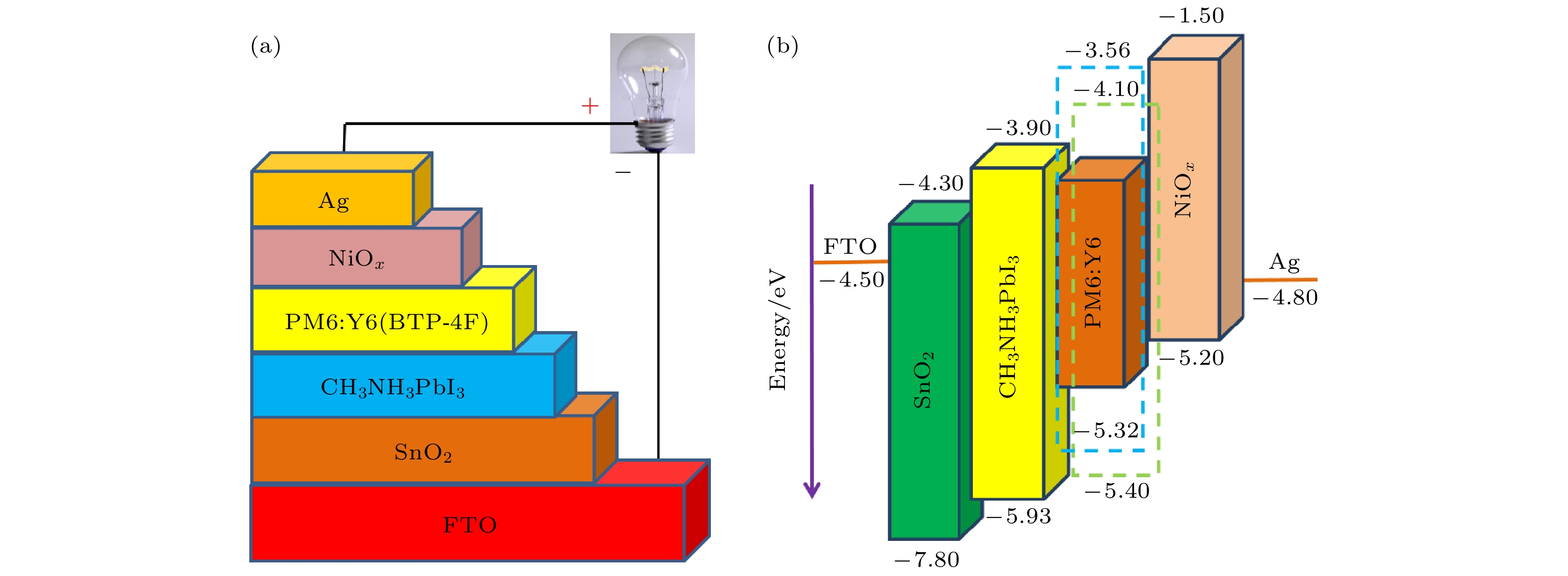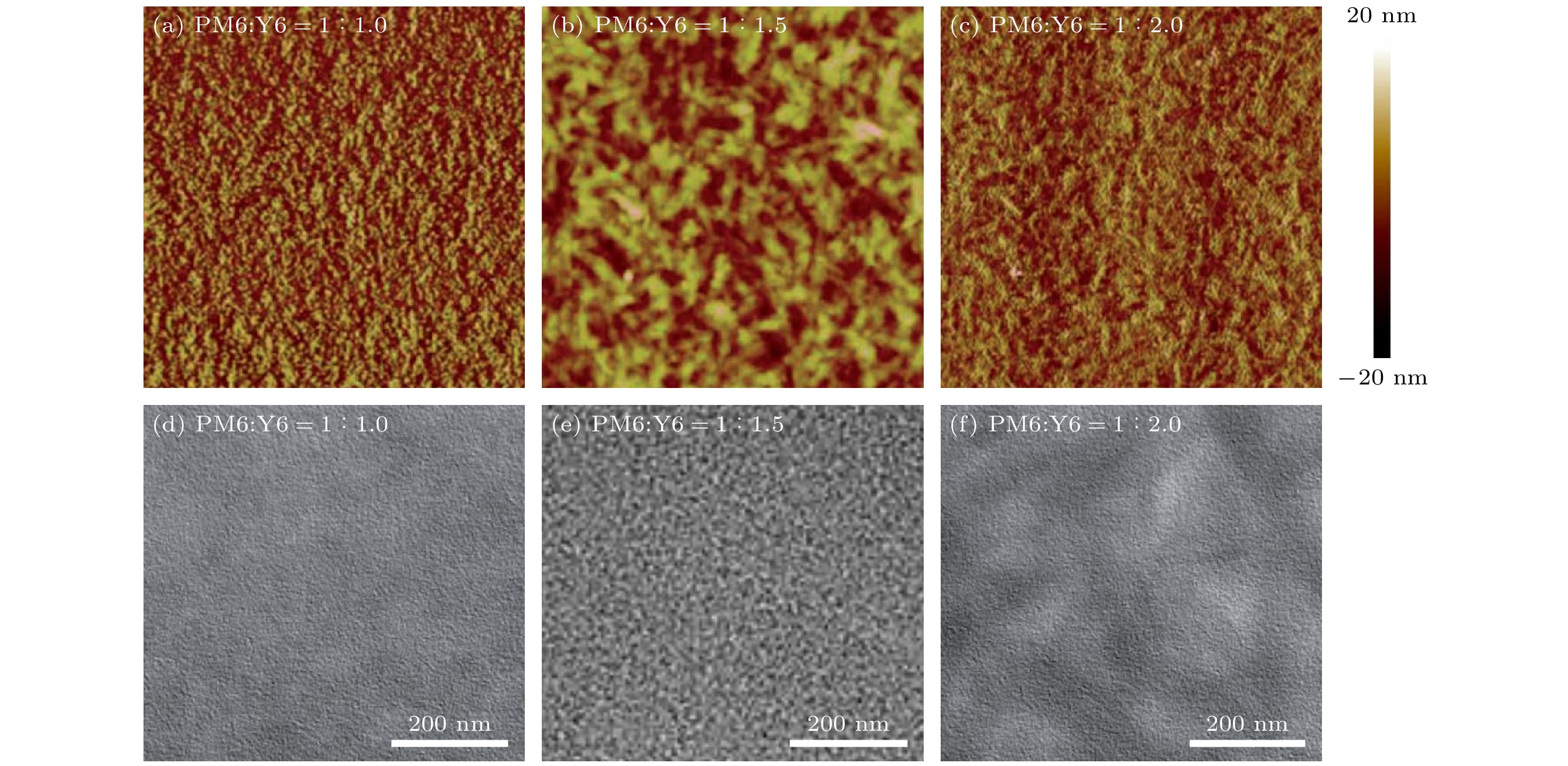-
通过工艺创新和薄膜优化技术成功制备基于CH3NH3PbI3/PM6:Y6(BTP-4F)的钙钛矿/有机集成太阳电池(IPOSCs). 通过添加剂1-8二碘辛烷DIO的调控和热退火处理, 极大优化CH3NH3PbI3/PM6:Y6混合薄膜质量和获得层间欧姆接触. 与此同时, 近红外区有机层的空穴和电子迁移率为 8.3×10–3 cm2 /(V·s)和8.8×10–3 cm2/(V·s), 可以和可见区钙钛矿层的空穴和电子迁移率相匹配, 实现在微观通路上达到载流子运输平衡, 导致器件具有高短路电流密度Jsc和高填充因子FF. 另外, 通过优化聚合物非富勒烯体系PM6:Y6质量比例混合成膜, 使得薄膜中的非辐射复合位点密度和载流子复合明显减少, 使得电子和空穴的提取和传输更加高效, 能够提供更大的驱动力来改善载流子传输, 同时形成更宽的耗尽区来抑制载流子复合以提高器件的开路电压Voc. 优化的集成太阳能电池的短路电流密度提升到25.88 A/cm2, 开路电压Voc增加到1.18 V, 填充因子FF达到80%, 光响应扩宽到950 nm, 外量子效率在可见光区达到90%, 最佳能量转换效率高达24.42%, 这是目前报道的IPOSCs中的最高效率之一. 结果表明, 通过可见区材料和近红外区聚合物非富勒烯体系材料组合和器件结构优化来增强钙钛矿太阳电池对于近红外光的吸收, 从而提升IPOSCs性能是一种有效的手段和方法. 为将来开发高效率IPOSCs奠定了实验工艺和构建理论基础.
-
关键词:
- 钙钛矿/有机集成太阳电池 /
- 聚合物非富勒烯体系 /
- 载流子运输平衡 /
- 非辐射复合
Integrated perovskite/organic solar cells (IPOSCs) based on CH3NH3PbI3/PM6:Y6(BTP-4F) are successfully prepared through process innovation and thin film optimization technology. The quality of CH3NH3PbI3/PM6:Y6 mixed films is greatly optimized, and the interlayer ohmic contact is obtained by regulating the additive DIO and annealing treatment. At the same time, the mobility of holes and electrons in the organic layer in the near infrared region are, respectively, 8.3×10–3 cm2/(V·s) and 8.8×10–3 cm2/(V·s), which can match the mobility of holes and electrons in the visible perovskite layer, achieving the carrier transport balance in the microscopic pathway. The device has high short-circuit current density Jsc and high filling factor FF. In addition, by optimizing the mass ratio of polymer non-fullerene system PM6:Y6 to form a film, the density of non-radiation recombination sites and carrier recombination in the film are significantly reduced, making the extraction and transport of electrons and holes more efficient, and providing greater driving force to improve carrier transport. At the same time, a wider depletion region is formed to inhibit carrier recombination and increase the open-circuit voltage Voc. The short-circuit current density of the optimized integrated solar cell increases to 25.88 A/cm2, the open-circuit voltage Voc increases to 1.18 V, the filling factor FF reaches 80%, the optical response expands to 950 nm, the external quantum efficiency reaches 90% in the visible region, and the optimal energy conversion efficiency is as high as 24.42%. This is one of the highest efficiencies reported in IPOSCs. The results show that it is an effective method to enhance the near-infrared light absorption of perovskite solar cells and improve the performance of IPOSCs by combining the materials in visible region and the polymer non-fullerene system in near infrared region and optimizing the device structure. It lays a theoretical foundation for developing high efficiency IPOSCs in the future.-
Keywords:
- integrated perovskite/organic solar cell /
- polymer non-fullerene system /
- carrier transport equilibrium /
- non-radiative recombination
[1] Jeong M, Choi I W, Go E M, Cho Y, Kim M, Lee B, Jeong S, Jo Y, Choi H W, Lee, Bae J H, Kwak S K, Kim D S, Yang C 2020 Science 369 1615
 Google Scholar
Google Scholar
[2] Al-Ashouri A, Kohnen E, Li B, Magomedov A, Hempel H, Caprioglio P, Marquez J A, Vilches A B M, Getautis V, Albrecht S 2020 Science 370 1300
 Google Scholar
Google Scholar
[3] Ono L K, Liu S Z, Qi Y B 2020 Angew. Chem. , Int. Edit. 59 6676
 Google Scholar
Google Scholar
[4] Jiang Q, Ni Z, Xu G, Lin Y, Rudd P N, Xue R, Li Y, Li Y, Gao Y, Huang J 2020 Adv. Mater. 32 2001581
 Google Scholar
Google Scholar
[5] Karlsson M, Yi Z, Reichert S, Luo X, Lin W, Zhang Z, Bao C, Friend R, Gao F 2021 Nat. Commun. 12 361
 Google Scholar
Google Scholar
[6] Dong Q S, Zhu C, Chen M, Jiang C, Guo J Y, Feng Y L, Zhou Y Y 2021 Nat. Commun. 12 9
 Google Scholar
Google Scholar
[7] Gao C, Yu H, Wang Y, Liu D, Wen T, Zhang L, Ge S, Yu J 2020 Anal. Chem. 92 6822
 Google Scholar
Google Scholar
[8] Li D Q, Geng F S, Hao T Y, Chen Z 2022 Nano Energy 96 107133
 Google Scholar
Google Scholar
[9] Gu B K, Du Y, Chen B, Zhao R, Lu H, Xu Q Y, Guo C X 2022 ACS Appl. Mater. Interfaces 14 11264
 Google Scholar
Google Scholar
[10] Yang X, Li B, Zhang X L, Li S Y 2023 Adv. Mater. DOI: 10.1002/adma.202301604
[11] Lin X F, Cheng P P, Zhang Y W, Tan W Y, Yu D S, Yi G B, Min Y G 2020 Sol. Energy 206 793
 Google Scholar
Google Scholar
[12] Lin X F, Wang Y Y, Wu J Y, Tang Z L, Lin W J, Nian L, Yi G B 2021 ACS Appl. Energy Mater. 4 5905
 Google Scholar
Google Scholar
[13] Ma R, Liu T, Luo Z, Guo Q, Xiao Y, Chen Y, Li X, Luo S, Lu X, Zhang M, Li Y, Yan H 2020 Sci. China:Chem. 63 325
 Google Scholar
Google Scholar
[14] Umeyama T, Igarashi K, Sasada D, Tamai Y, Ishida K, Koganezawa T, Ohtani S, Tanaka K, Ohkita H, Imahori H 2020 Chem. Sci. 11 3250
 Google Scholar
Google Scholar
[15] Umeyama T, Igarashi K, Sasada D, Ishida K, Tanaka K, Imahori H 2020 ACS Appl. Mater. Interfaces 12 39236
 Google Scholar
Google Scholar
-
图 6 纯钙钛矿太阳电池、有机光伏电池和IPOSCs的光伏性能、外量子效率、载流子以及阻抗测试 (a)纯钙钛矿太阳电池光伏性能J-V曲线; (b) OSC光伏性能J-V曲线; (c) IPOSCs光伏性能J-V曲线; (d) EQE曲线和积分电流曲线; (e)空穴迁移率; (f)电化学阻抗谱
Fig. 6. Photovoltaic performance, external quantum efficiency, carrier and impedance tests of pure perovskite solar cells, organic photovoltaic cells and IPOSCs: (a) J-V curves of photovoltaic performance of pure perovskite solar cells; (b) J-V curves of photovoltaic performance of organic solar cells; (c) performance J-V curves of IPOSCs; (d) EQE curves and integral current curves; (e) hole mobility; (f) electrochemical impedance spectroscopy.
表 1 IPOSCs光伏性能参数
Table 1. Photovoltaic performance parameters of IPOSCs.
CH3NH3PbI3/
PM6:Y6Voc/V Jsc/(mA·cm–2) FF/% PCE/% 1∶1 1.17 25.02 79 23.12 1∶1.5 1.18 25.88 80 24.42 1∶2 1.16 24.01 78 21.70 -
[1] Jeong M, Choi I W, Go E M, Cho Y, Kim M, Lee B, Jeong S, Jo Y, Choi H W, Lee, Bae J H, Kwak S K, Kim D S, Yang C 2020 Science 369 1615
 Google Scholar
Google Scholar
[2] Al-Ashouri A, Kohnen E, Li B, Magomedov A, Hempel H, Caprioglio P, Marquez J A, Vilches A B M, Getautis V, Albrecht S 2020 Science 370 1300
 Google Scholar
Google Scholar
[3] Ono L K, Liu S Z, Qi Y B 2020 Angew. Chem. , Int. Edit. 59 6676
 Google Scholar
Google Scholar
[4] Jiang Q, Ni Z, Xu G, Lin Y, Rudd P N, Xue R, Li Y, Li Y, Gao Y, Huang J 2020 Adv. Mater. 32 2001581
 Google Scholar
Google Scholar
[5] Karlsson M, Yi Z, Reichert S, Luo X, Lin W, Zhang Z, Bao C, Friend R, Gao F 2021 Nat. Commun. 12 361
 Google Scholar
Google Scholar
[6] Dong Q S, Zhu C, Chen M, Jiang C, Guo J Y, Feng Y L, Zhou Y Y 2021 Nat. Commun. 12 9
 Google Scholar
Google Scholar
[7] Gao C, Yu H, Wang Y, Liu D, Wen T, Zhang L, Ge S, Yu J 2020 Anal. Chem. 92 6822
 Google Scholar
Google Scholar
[8] Li D Q, Geng F S, Hao T Y, Chen Z 2022 Nano Energy 96 107133
 Google Scholar
Google Scholar
[9] Gu B K, Du Y, Chen B, Zhao R, Lu H, Xu Q Y, Guo C X 2022 ACS Appl. Mater. Interfaces 14 11264
 Google Scholar
Google Scholar
[10] Yang X, Li B, Zhang X L, Li S Y 2023 Adv. Mater. DOI: 10.1002/adma.202301604
[11] Lin X F, Cheng P P, Zhang Y W, Tan W Y, Yu D S, Yi G B, Min Y G 2020 Sol. Energy 206 793
 Google Scholar
Google Scholar
[12] Lin X F, Wang Y Y, Wu J Y, Tang Z L, Lin W J, Nian L, Yi G B 2021 ACS Appl. Energy Mater. 4 5905
 Google Scholar
Google Scholar
[13] Ma R, Liu T, Luo Z, Guo Q, Xiao Y, Chen Y, Li X, Luo S, Lu X, Zhang M, Li Y, Yan H 2020 Sci. China:Chem. 63 325
 Google Scholar
Google Scholar
[14] Umeyama T, Igarashi K, Sasada D, Tamai Y, Ishida K, Koganezawa T, Ohtani S, Tanaka K, Ohkita H, Imahori H 2020 Chem. Sci. 11 3250
 Google Scholar
Google Scholar
[15] Umeyama T, Igarashi K, Sasada D, Ishida K, Tanaka K, Imahori H 2020 ACS Appl. Mater. Interfaces 12 39236
 Google Scholar
Google Scholar
计量
- 文章访问数: 11700
- PDF下载量: 340
- 被引次数: 0














 下载:
下载:






